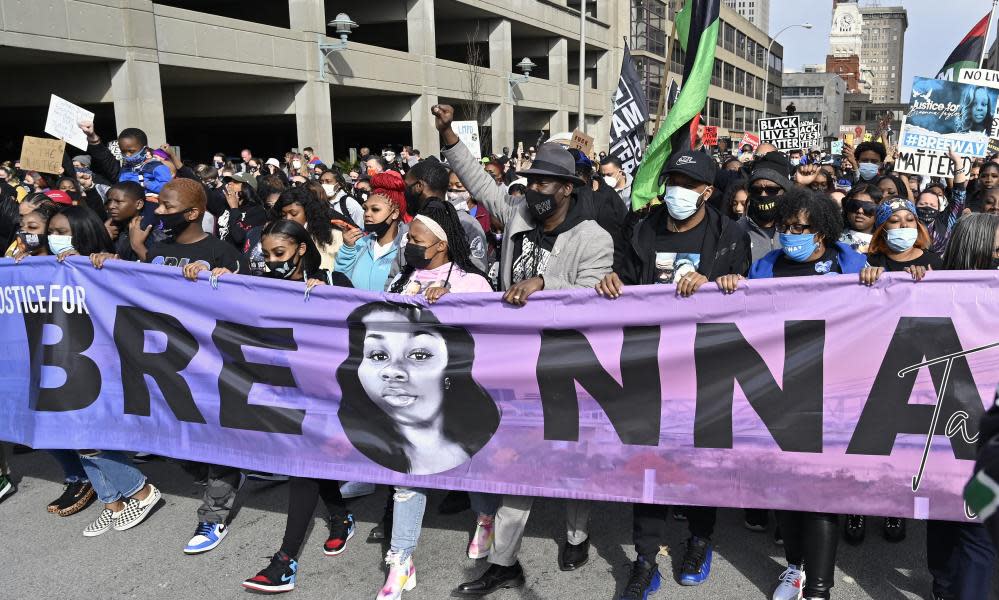The killings of Black women: five findings from our investigation

Five Black women and girls were killed every day in the United States in 2020, as a national increase in gun violence during the pandemic took a heavy toll on some of the country’s most vulnerable people.
In all 1,821 Black women and girls were killed in 2020. That was an additional 461 women and girls who were murdered in 2020 compared with 2019 – more than one additional killing a day.
Related: ‘An unspoken epidemic’: Homicide rate increase for Black women rivals that of Black men
As part of a new Guardian series on the homicides of Black women and girls, here’s what we know – and what we don’t yet know – about this “unspoken epidemic”, and the important findings of our data investigation into the killings.
Black women and girls in the US are four times more likely to die by violence than white or Hispanic women
The national homicide rate for Black women and girls in 2020 was eight homicides per 100,000 people. That’s the highest rate among American women, and represents a risk of violent death that is four times higher than white or Latina women.
Indigenous women and girls face the next-highest risk, at 5.8 homicides per 100,000 people.
Even though American men make up the majority of homicide victims, both Black and Indigenous women and girls face a homicide risk that is higher than that of white men and boys (4.7 homicides per 100,000 people).
In 2020, about 75% of Black female homicide victims were killed with a gun.
During the pandemic, homicides of Black women and girls tripled in Kentucky, more than doubled in the District of Columbia, and doubled in Wisconsin and Ohio
In Kentucky, where Breonna Taylor’s killing by white police officers in Louisville sparked national protests, homicides of Black women and girls statewide tripled in 2020, from 10 women and girls killed to 33, compared with the year before. In Wisconsin and Ohio these killings doubled, rising from 21 to 42 and from 57 to 110 respectively.
In Washington DC, the nation’s capital, homicides of Black women more than doubled, from 10 to 25. No women of any other race were murdered in the district in 2020, according to the police department.
The graphic below shows the homicide rate of Black women and girls per 100,000.
The increase in these states, researchers and state officials say, points to larger racial disparities in the midwest, ranging from overall life expectancy to deaths from heart disease, and incarceration rates. And though Washington DC is home to some of America’s most powerful Black people, it is also a majority Black city where many residents face intense disadvantages.
There are big differences in Black women’s risk of violent death across different regions of the country. New York and New Jersey, for instance, saw substantial increases in the homicide rate for Black women and girls in 2020. But even after 2020’s increases, Black women and girls living in Wisconsin and Missouri still faced a homicide risk five times higher than Black women and girls living in New York.
Overall, it’s in America’s midwest, as well as in some southern states bordering the midwest, where Black women face the overall highest risk of being murdered, not in the deep south.
Nationwide, the homicide rate for Black women and girls increased 33% in 2020 – a sharply higher increase than women or girls of other races, and one that rivaled the rate increase for Black men and boys
Across racial groups, American men saw big increases in their homicide rates in 2020, leaving thousands more men dead compared with the year before.
But there was a much sharper racial disparity among women, with Black women’s homicide risk increasing much more than any other group.
Many Black women and girls are killed by intimate partners, family members, or other people they know. But there are big gaps in national law enforcement data about the perpetrators of these killings
Like most American women, Black women and girls are often killed by someone they know. Nearly a third of Black women and girls in 2020 were known to be killed by an intimate partner or a family member, according to law enforcement homicide data reported to the FBI, and another 16% were killed by a friend, neighbor or acquaintance.
But there are significant gaps in national law enforcement data about their murders. For nearly half of the killings of Black women and girls in 2020, the FBI’s supplementary homicide report lists the relationship between the victim and the person who killed her as “unknown”.
Half the recorded killings of trans and gender non-conforming people in 2020 were killings of Black trans women
National homicide statistics do not identify whether victims are trans or gender non-conforming, and law enforcement agencies frequently misgender trans homicide victims.
In 2020, half the 46 recorded homicides of trans and gender non-confirming people nationwide were killings of Black trans women, according to the Human Rights Campaign (HRC), which tracks these deaths.
That number is rising: at least 34 Black trans women were killed in 2021, the organization said.
In all, since 2013, at least 175 Black trans women have been killed in the United States, representing the majority of the 270 trans and gender non-confirming deaths HRC has recorded. The organization includes profiles paying tribute to each of the people lost on its website.

 Yahoo Movies
Yahoo Movies 
